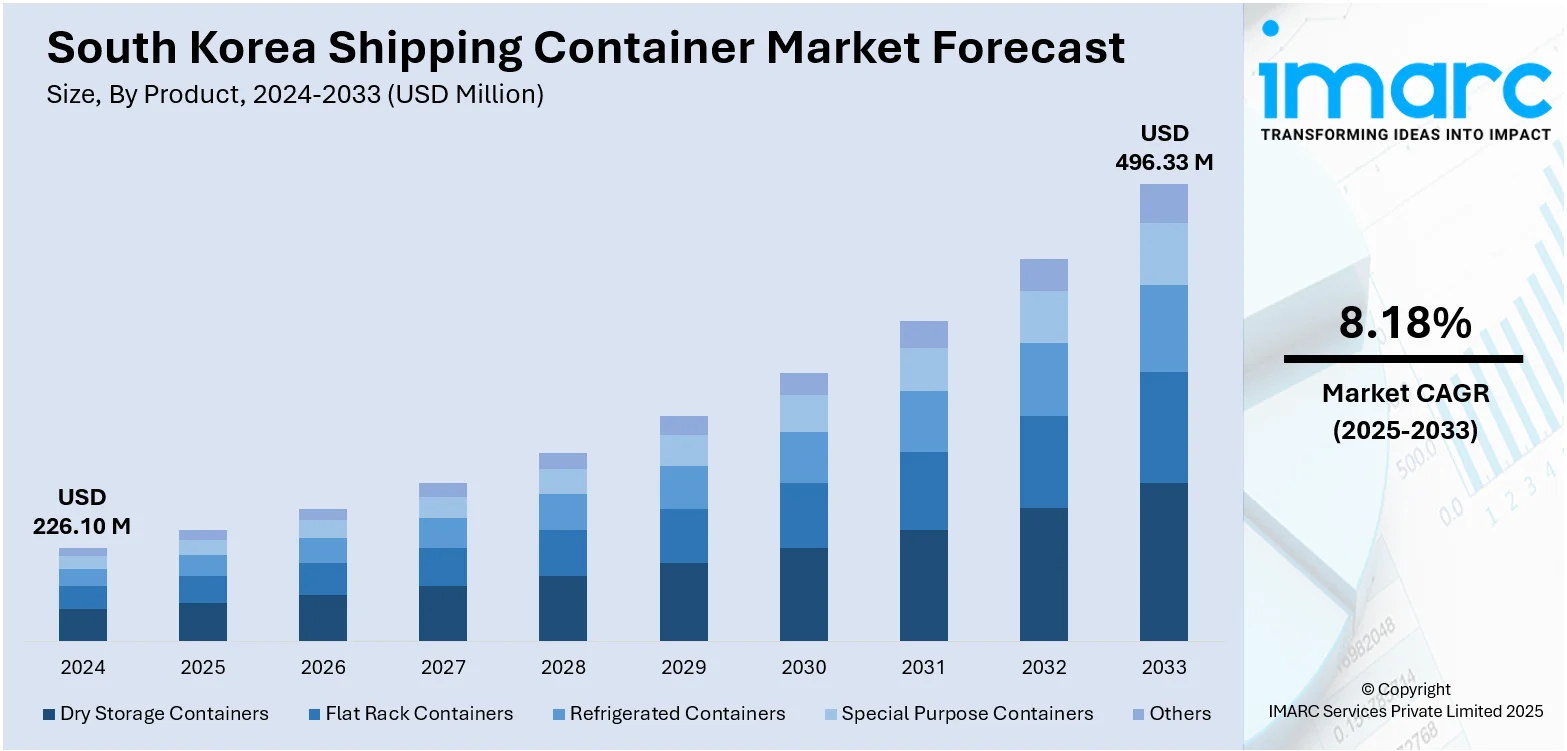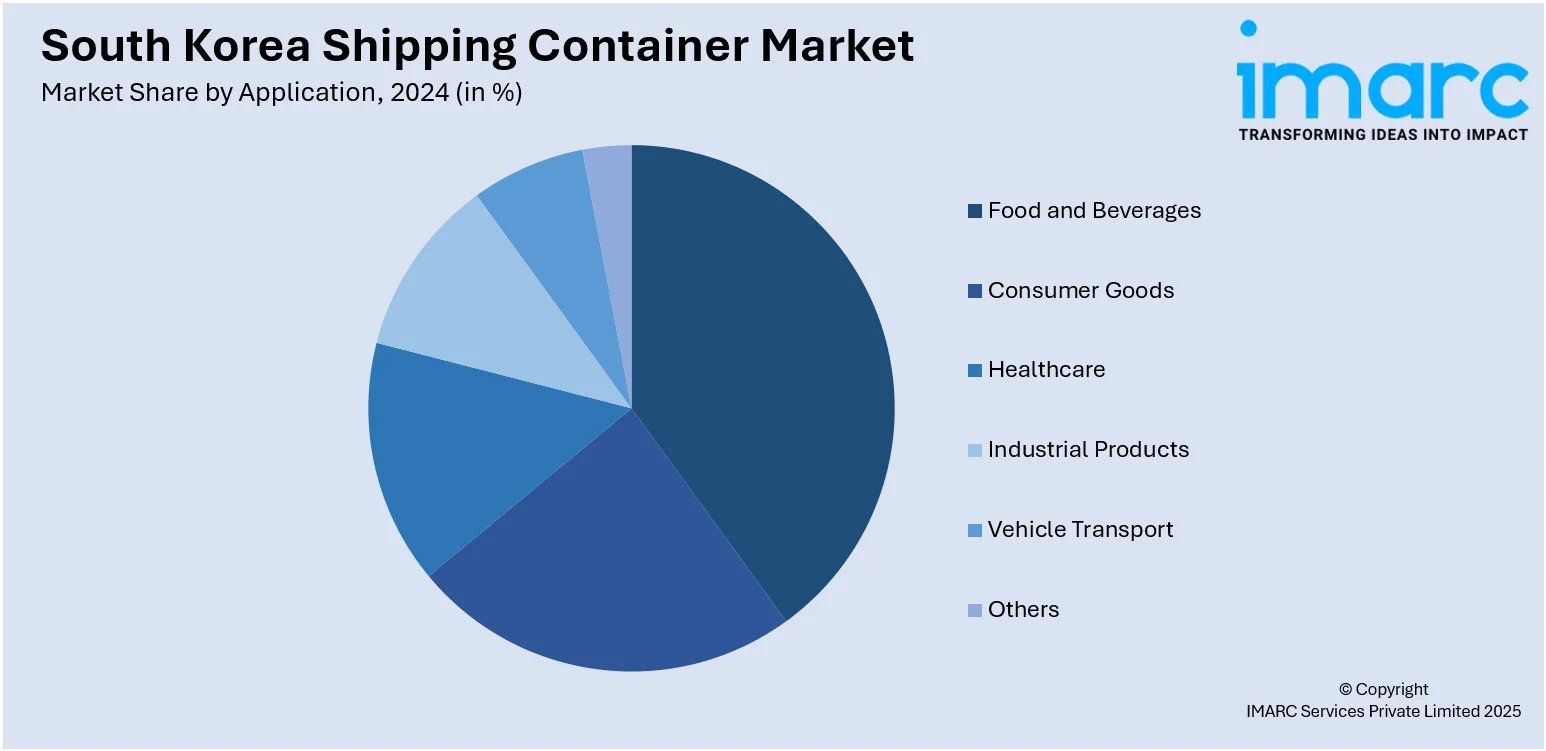
South Korea Shipping Container Market Size, Share, Trends and Forecast by Product, Container Size, Application, and Region, 2025-2033
South Korea Shipping Container Market Overview:
The South Korea shipping container market size reached USD 226.10 Million in 2024. Looking forward, the market is expected to reach USD 496.33 Million by 2033, exhibiting a growth rate (CAGR) of 8.18% during 2025-2033. The market is anchored by world-class ports like Busan and Incheon, modern fleets from national carriers such as HMM, and state-of-the-art port infrastructure. Its position on major East Asian shipping routes, combined with smart-port technologies and supportive government policies, enhances efficiency and sustainability. Together, these trends strengthen the South Korea shipping container market share.
|
Report Attribute
|
Key Statistics
|
|---|---|
|
Base Year
|
2024
|
|
Forecast Years
|
2025-2033
|
|
Historical Years
|
2019-2024
|
| Market Size in 2024 | USD 226.10 Million |
| Market Forecast in 2033 | USD 496.33 Million |
| Market Growth Rate 2025-2033 | 8.18% |
South Korea Shipping Container Market Trends:
Strategic Geographic Location and Global Trade Connectivity
South Korea’s strategic position along key East Asian maritime trade routes makes it a vital logistics hub in global shipping. Ports like Busan, one of the busiest in the world, serve as critical transshipment points connecting Northeast Asia with Europe, North America, and Southeast Asia. This geographic advantage drives consistent demand for shipping containers to manage high cargo volumes efficiently. Moreover, South Korea maintains strong trade relations with major economies such as China, the United States, and the European Union, further boosting containerized exports and imports. The country's focus on enhancing intermodal transport and expanding port capacities supports seamless cargo flow, reinforcing the steady demand for shipping containers across domestic and international trade routes.

To get more information on this market, Request Sample
Technological Advancements and Smart Port Development
The South Korean government and port authorities are heavily investing in automation and smart port technologies to improve logistics efficiency, which is boosting the South Korea shipping container market growth. Implementation of AI, IoT, and digital twin systems in ports such as Busan and Incheon enables real-time cargo tracking, predictive maintenance, and automated container handling. These innovations reduce turnaround times, lower operational costs, and increase throughput, thereby encouraging greater usage of containerized freight. Additionally, eco-friendly initiatives like electrified cranes and low-emission port operations align with global sustainability standards. This emphasis on digital transformation not only modernizes port infrastructure but also elevates demand for specialized and technologically integrated shipping containers, positioning South Korea at the forefront of smart maritime logistics in Asia.
Government Support and Export-Oriented Economy
South Korea's export-driven economy significantly shapes its shipping container market. With electronics, automotive, chemicals, and machinery as key export sectors, the need for reliable and efficient containerized shipping remains strong. The government plays an active role in supporting maritime logistics through infrastructure investments, favorable trade policies, and subsidies for port upgrades and vessel modernization. National carriers like HMM have also expanded their container fleets with government backing, strengthening international shipping capacity. Additionally, South Korea’s push to diversify trade routes and participate in global logistics initiatives further bolsters container demand. These policy-driven efforts ensure a stable supply chain environment and reinforce the long-term growth of the shipping container market in the country.
South Korea Shipping Container Market Segmentation:
IMARC Group provides an analysis of the key trends in each segment of the market, along with forecasts at the country and regional levels for 2025-2033. Our report has categorized the market based on product, container size, and application.
Product Insights:
- Dry Storage Containers
- Flat Rack Containers
- Refrigerated Containers
- Special Purpose Containers
- Others
The report has provided a detailed breakup and analysis of the market based on product. This includes dry storage containers, flat rack containers, refrigerated containers, special purpose containers, and others.
Container Size Insights:
- Small Containers (20 feet)
- Large Containers (40 feet)
- High Cube Containers
- Others
A detailed breakup and analysis of the market based on the container size have also been provided in the report. This includes small containers (20 feet), large containers (40 feet), high cube containers, and others.
Application Insights:

- Food and Beverages
- Consumer Goods
- Healthcare
- Industrial Products
- Vehicle Transport
- Others
A detailed breakup and analysis of the market based on the application have also been provided in the report. This includes food and beverages, consumer goods, healthcare, industrial products, vehicle transport, and others.
Regional Insights:
- Seoul Capital Area
- Yeongnam (Southeastern Region)
- Honam (Southwestern Region)
- Hoseo (Central Region)
- Others
The report has also provided a comprehensive analysis of all the major regional markets, which include Seoul Capital Area, Yeongnam (Southeastern Region), Honam (Southwestern Region), Hoseo (Central Region), and others.
Competitive Landscape:
The market research report has also provided a comprehensive analysis of the competitive landscape. Competitive analysis such as market structure, key player positioning, top winning strategies, competitive dashboard, and company evaluation quadrant has been covered in the report. Also, detailed profiles of all major companies have been provided.
South Korea Shipping Container Market News:
- In February 2025, HD Korea Shipbuilding & Offshore Engineering of South Korea introduced a conceptual model of a nuclear-powered container vessel featuring small modular reactor (SMR) technology. The innovative design was showcased on February 12 during the New Nuclear for Maritime Houston Summit, hosted at the Asia Society Texas Center in Houston, United States.
- In March 2025, South Korea introduced its first container vessel built for autonomous navigation. Hyundai Mipo Dockyard, a subsidiary of HD Hyundai Shipbuilding, completed the construction of two 1,800 TEU ships, Force Singapore and Force Laem Chabang, at the same time. Among them, Force Singapore has been designated as the country’s first demonstration ship for autonomous operations.
South Korea Shipping Container Market Report Coverage:
| Report Features | Details |
|---|---|
| Base Year of the Analysis | 2024 |
| Historical Period | 2019-2024 |
| Forecast Period | 2025-2033 |
| Units | Million USD |
| Scope of the Report |
Exploration of Historical Trends and Market Outlook, Industry Catalysts and Challenges, Segment-Wise Historical and Future Market Assessment:
|
| Products Covered | Dry Storage Containers, Flat Rack Containers, Refrigerated Containers, Special Purpose Containers, Others |
| Container Sizes Covered | Small Containers (20 feet), Large Containers (40 feet), High Cube Containers, Others |
| Applications Covered | Food and Beverages, Consumer Goods, Healthcare, Industrial Products, Vehicle Transport, Others |
| Regions Covered | Seoul Capital Area, Yeongnam (Southeastern Region), Honam (Southwestern Region), Hoseo (Central Region), Others |
| Customization Scope | 10% Free Customization |
| Post-Sale Analyst Support | 10-12 Weeks |
| Delivery Format | PDF and Excel through Email (We can also provide the editable version of the report in PPT/Word format on special request) |
Key Questions Answered in This Report:
- How has the South Korea shipping container market performed so far and how will it perform in the coming years?
- What is the breakup of the South Korea shipping container market on the basis of product?
- What is the breakup of the South Korea shipping container market on the basis of container size?
- What is the breakup of the South Korea shipping container market on the basis of application?
- What is the breakup of the South Korea shipping container market on the basis of region?
- What are the various stages in the value chain of the South Korea shipping container market?
- What are the key driving factors and challenges in the South Korea shipping container market?
- What is the structure of the South Korea shipping container market and who are the key players?
- What is the degree of competition in the South Korea shipping container market?
Key Benefits for Stakeholders:
- IMARC’s industry report offers a comprehensive quantitative analysis of various market segments, historical and current market trends, market forecasts, and dynamics of the South Korea shipping container market from 2019-2033.
- The research report provides the latest information on the market drivers, challenges, and opportunities in the South Korea shipping container market.
- Porter's five forces analysis assist stakeholders in assessing the impact of new entrants, competitive rivalry, supplier power, buyer power, and the threat of substitution. It helps stakeholders to analyze the level of competition within the South Korea shipping container industry and its attractiveness.
- Competitive landscape allows stakeholders to understand their competitive environment and provides an insight into the current positions of key players in the market.
Need more help?
- Speak to our experienced analysts for insights on the current market scenarios.
- Include additional segments and countries to customize the report as per your requirement.
- Gain an unparalleled competitive advantage in your domain by understanding how to utilize the report and positively impacting your operations and revenue.
- For further assistance, please connect with our analysts.
 Request Customization
Request Customization
 Speak to an Analyst
Speak to an Analyst
 Request Brochure
Request Brochure
 Inquire Before Buying
Inquire Before Buying




.webp)




.webp)












